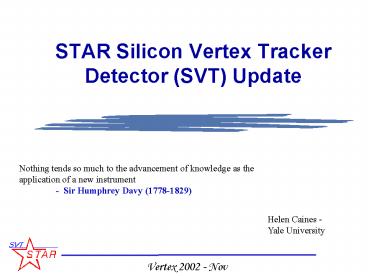STAR Silicon Vertex Tracker Detector (SVT) Update - PowerPoint PPT Presentation
Title:
STAR Silicon Vertex Tracker Detector (SVT) Update
Description:
... advancement of knowledge as the application of a new instrument ... Magnitudes agree with survey results. Shifted center of SVT. Relative to TPC by. x=-0.276cm ... – PowerPoint PPT presentation
Number of Views:28
Avg rating:3.0/5.0
Title: STAR Silicon Vertex Tracker Detector (SVT) Update
1
STAR Silicon Vertex Tracker Detector (SVT) Update
Nothing tends so much to the advancement of
knowledge as the application of a new instrument
- Sir Humphrey Davy (1778-1829)
Helen Caines - Yale University
2
(No Transcript)
3
Presentation Overview
- SVT Introduction
- SVT Performance
- Track-to-Hit Matching
- Vertex Reconstruction
- Energy Loss
- Strange Particle Decays
- Summary Conclusions
4
Welcome to BNL- RHIC!
5
The STAR Detector
Magnet
Coils
Silicon Vertex Tracker
TPC Endcap MWPC
ZCal
ZCal
Endcap Calorimeter
Barrel EM Calorimeter
Central Trigger Barrel TOF patch
RICH
yr.1 SVT ladder
- 1st year, 2nd year, year-by-year until 2003,
installation in 2003
6
SVT Installation
Installed for the first time 2001-2 RHIC run
7
p-p vs Au-Au at vsNN200 GeV
Two very different environments p-p - Few
tracks, primary vertex not well
known high luminosity
Au-Au Few 1000 tracks Vertex well
located Track/hit merging
8
SVT Design
Each wafer is 6.3 cm x 6.3 cm area 300 mm thick
- 0.3X0 Average radiation length seen by a
particle 4.5X0 incl. fee cards etc. Consists
of 216 wafers
3 Barrels Outer radius 15cm Middle Radius
10cm Inner radius - 6cm Length - ?21cm
Inner barrel has 8 ladders 4
wafers/ladder Middle barrel has 12 ladders 6
wafers/ladder Outer barrel has 16 ladders
7 wafers/ladder
9
Silicon Drift Detector - Principle
Ionizing particle
Z - position from readout anode number
Drift time 5 msec 240 Anodes/wafer 100
samples/anode
SDD
R - position from drift time
X
Electron cloud
Gain 1 e- 7.2mV 4 mV 1
ADC
10
Calibrations - Pedestals
First Time bucket
Pedestal Subtraction done online
Other 127 Time buckets
Anode
You can see the edges of the 15 PASAs and more
obviously the 3 analogue buffers where the
multiplexing occurs
96.5 of 103,680 channels operational 91.2 of
103,680 channels used in analysis
11
SVT Performance
counts
- Noise
- 7 mV for pp
- 12 mV for AuAu (due to a grounding problem
now fixed) - 4 mV design (lt7 mV aim)
cm
- 30 mm resolution reproducibility
12
Drift Velocity Calibration
SDDs modeled using 2 drift velocities. One in
the drift region and one in the focusing region
There is a temperature dependence across the
wafer which must be accounted for.
13
SVT Temperature Control
Au-Au
14
Hit to Track Matching
TPC inner radius 50cm SVT outer radius
15cm Project tracks from TPC to SVT
Are we matching correctly?
15
Drift Residuals vs Wafer
Before Alignment
Shifted center of SVT Relative to TPC by
x-0.276cm y-0.82cm
2
3
1
16
Using SVT for TPC Calibration
Track dip angle lt 0.1
mean D(Z) 0.0526cm vdrift 5.56
cm/msec ?TPC T0 shift 0.0526/5.56
9.46 x 10-3 msec
After Corrections
Shift in Z TPC T0/Vdrift wrong
17
Vertex Finding - Resolution
p-p
STAR Preliminary
Z offset of 0.005cm Aligned in Z
18
Anode Residuals vs pt
STAR Preliminary
Pt resolution worse at low pt where energy loss
and scattering not yet taken into account
Au-Au
19
Primary Matching efficiency
Efficiency is defined as the number of tracks
with SVT hits added (2 or more)
p-p
If you go to 30cm average effic is 45
Flat in pt
Expect 85 from simulation of perfect detector
p-p
20
Impact Parameter Improvement
3D impact parameters of track associated to
primary vertex ? should be close to zero
pp Mean 0.7-gt0.51 cm RMS 0.59-gt0.48 cm
TPC
TPCSVT
cm
21
Energy Loss in the SVT Layers
- 3 sample maximum
- Higher energy resolution
- Good for low momentum
Preliminary
Preliminary
p
- Independent measure of dE/dx
- Allows 2D cut
22
Strange Particle Decays
- Black is TPC only
- Red is TPCSVT
35-40 greater yield in K0s region
Preliminary
Preliminary
- Blue is TPC only
- Red is TPCSVT
Mostly low pT
23
Summary Conclusions
- Sharpens the primary vertex reconstruction
- Improved PID
- More precise low pT tracking
- Enhanced analyses (already 40 more K0)
- To Do
- Improve noise reduction
- Understand track to hit matching
- Take more data!
24
The STAR Collaboration
- Russia
- MEPHI - Moscow
- LPP/LHE JINR - Dubna
- IHEP - Protvino
- U.S. Labs
- Argonne
- Berkeley
- Brookhaven
- U.S. Universities
- Arkansas University
- UC Berkeley
- UC Davis
- UC Los Angeles
- Carnegie Mellon University
- Creighton University
- Indiana University
Brazil Universidade de Sao Paolo China IHEP
Beijing, IMP - Lanzou IPP Wuhan USTC SINR
Shanghai Tsinghua University England University
of Birmingham France IReS Strasbourg SUBATECH -
Nantes Germany MPI Munich University of
Frankfurt India IOP - Bhubaneswar VECC -
Calcutta Panjab University University of
Rajasthan Jammu University IIT - Bombay VECC
Kolcata Poland Warsaw University of Technology































